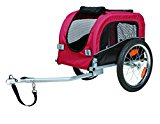Bike trailer for kids purchasing advice: how to choose the right product
- The most important facts in brief
- Child bike trailers are the safe and comfortable alternative to child bike seats.
- Many child trailers are two-seaters, so there is room for two children.
- If a baby seat, hammock or seat reducer is fitted in the trailer, babies can also ride along.
- For their own safety, the child must always be strapped in and should wear a helmet.
- Many children’s bicycle trailers can be converted into a jogger or buggy.
Child transport made easy
If you have children, you want to take them out and show them the world in a playful way. However, long distances are tedious on foot, which is why many parents resort to a car or bicycle. There are child seats for cars and also for bicycles. A practical alternative to child bike seats is a bicycle trailer. This allows children to be transported safely strapped in and protected by a canopy.
Does a children’s bicycle trailer fit on every bicycle?
In principle, a children’s bicycle trailer fits on any bicycle, even on an e-bike, provided it is equipped with a suitable hitch. Although the child bike trailer theoretically also fits on S-pedelecs, it must not be attached to them, as these electric bikes can reach a speed of up to 45 kilometres per hour.
Safe and spacious – The advantages of a bicycle trailer for children
A children’s bicycle trailer is suitable for a wide variety of cycling tours with a child. Whether you are cycling in the city, on the flat countryside or in the forest; the suspension of the trailer allows you to ride in any environment. It ensures that the child is not shaken back and forth too much and cushions the ride even on very bumpy roads.
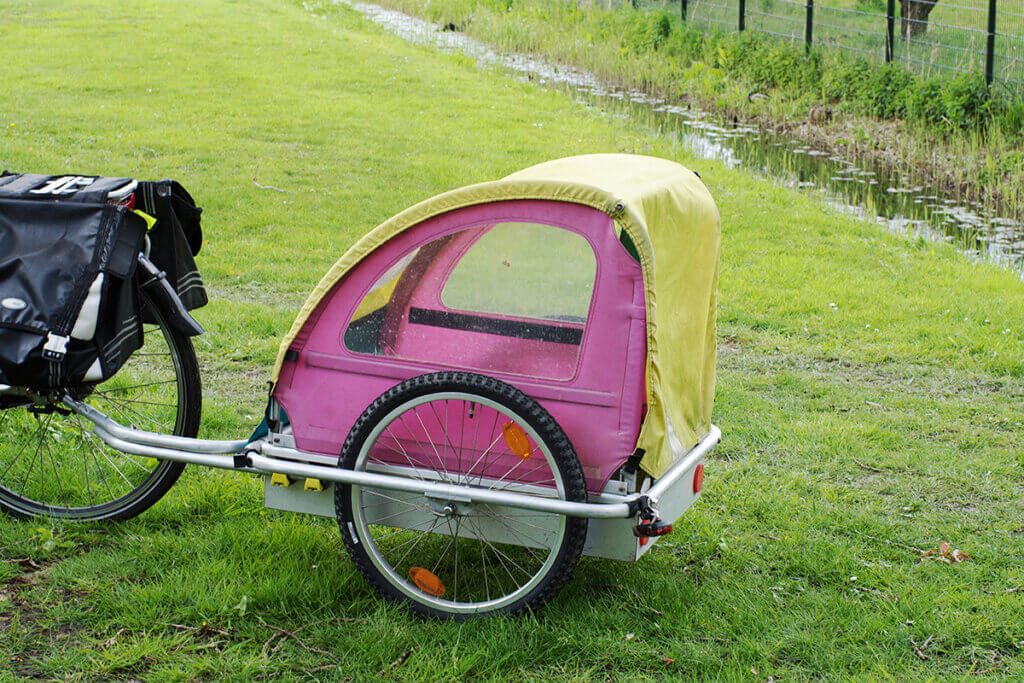
Advantages over a child seat
Since a child bike trailer acts as an alternative to a child bike seat, it is worth taking a look at its advantages over it. First of all, the age of the child is less relevant when riding in a bicycle trailer. For a bicycle seat, the child should already be able to sit independently, which is usually the case from around the ninth month. In a bicycle trailer, on the other hand, newborns can already ride along because of the possible lying position. Children who are too small for their own bicycle can thus safely experience the fun of getting around. A decisive advantage for families with several children is also the possibility of transporting two children in one child trailer. In contrast to a bicycle seat, the child also has more freedom of movement and sits much more comfortably. This makes cycling tours more pleasant, as the child is less cranky.
In contrast to a bicycle seat, a bicycle trailer is equipped with outer walls and a canopy and usually also has a rain cover and a net against insects. This enables bicycle excursions in any weather, because the child is protected against wind, rain and sun at all times. A bicycle trailer is particularly suitable for long trips because it is comfortable for children. So even multi-day tours and longer cycling holidays are no problem.
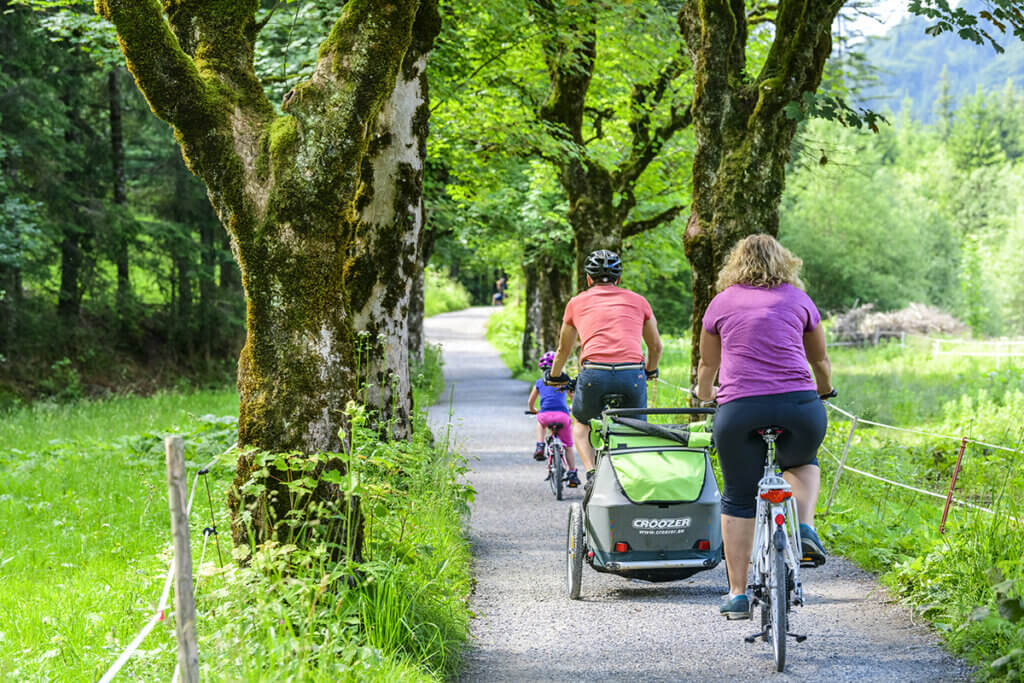
A great advantage of the child trailer is its storage space. While there is only room for the child itself in a bicycle seat, a bicycle trailer offers the possibility of transporting a wide variety of additional things. For example, there is room for a change of clothes or shopping, which is practical on longer tours. So that the child does not get bored, various toys can also be taken along. Pillows and blankets that increase the child’s comfort can also be easily stowed in the trailer. For camping trips, sleeping bags and tents can also be transported well in the bicycle trailer.
Bicycle trailers are considered safer than bicycle seats. The trailer is closer to the ground, which makes a fall less dangerous. Since a bicycle seat is directly on the bicycle, the child falls as soon as the cyclist stumbles. A bicycle trailer usually does not tip over even if the cyclist falls. This means that riding in a bicycle trailer is much safer for the child than in a bicycle seat. It is strapped in and sits like in a cage that protects it from all sides.
Many child trailers are also multifunctional and can be quickly converted into a buggy or a so-called jogger. Anyone who wants to take their child with them not only on bicycle tours but also for jogging or walking will benefit from such a bicycle trailer.
From what age can children ride in a child trailer?
Legally, there is no minimum age for riding in a child bike trailer. Therefore, you can already put your newborn child in the trailer. However, as vibrations can be harmful to a baby’s spine, you will need a baby seat, a hammock or a seat reducer. Many manufacturers state that their trailer may not be used until a certain age, for example from 9 months. According to road traffic regulations, children older than seven years are no longer allowed to ride in a children’s bicycle trailer.
What you should look for when buying a children’s bicycle trailer
If you want to buy a children’s bicycle trailer, you should pay attention to certain details. Most important are the suspension, the type of model, the wheels, the test seals, and the material.
The number of seats
First of all, you need to consider whether you want to buy a one-seater or a two-seater. If you have two children, a two-seater is very practical and even if only one child uses it, there is more space for shopping, clothes and toys in a trailer with two seats. However, such a trailer is larger, bulkier and significantly more expensive than a one-seater. If you only want to transport one child, a single-seater is therefore usually sufficient.
Suspension
Suspension is very important for the comfort of the child. Cheaper trailers do not always have suspension, but it is standard on almost all mid- and high-priced models. When buying a child trailer, make sure that it has high-quality suspension. You can recognise this by the fact that it can be adjusted to the weight of your child and absorbs shocks so that the child is not thrown up and down in the trailer.
Wheels
Depending on the model, a bicycle trailer has one, two or three wheels. The tyre sizes and tyre widths also differ greatly. Large tyres are recommended because they make bumps in the ground less noticeable and provide a better overall ride than smaller versions. The wheel diameter should be between 16 and 20 inches and the track width should not be more than 90 centimetres. The wheels themselves should stand slightly outwards, because then they provide stability and the trailer does not tip over so quickly.
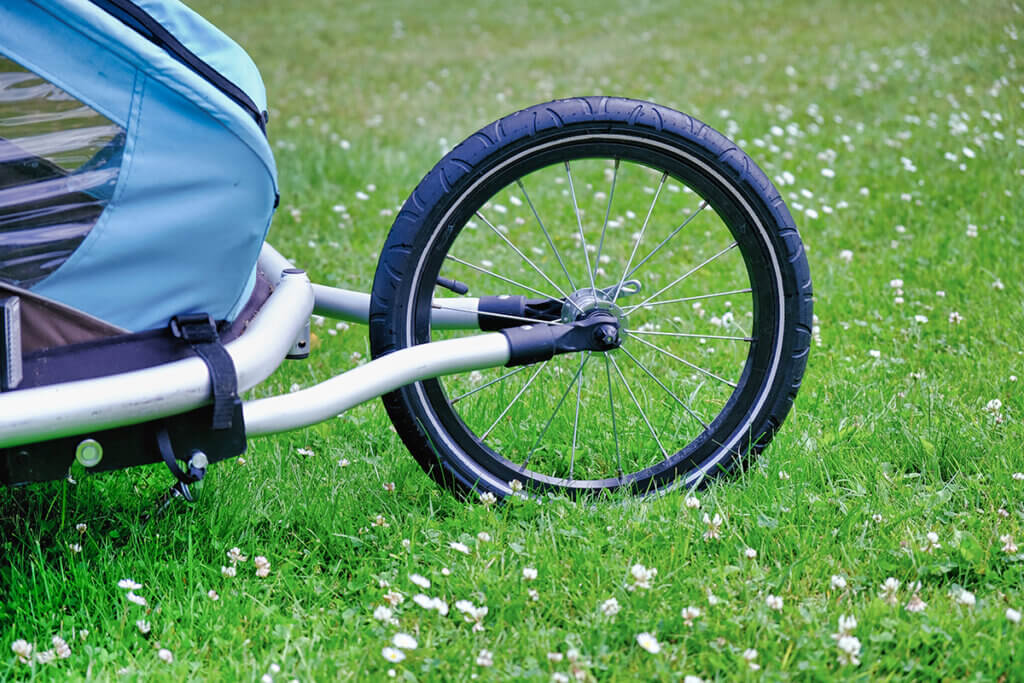
Material
Many children’s bicycle trailers consist of a steel or aluminium frame covered with plastic. Aluminium versions are lighter and therefore easier to transport. So if you often have to carry the trailer up and down stairs, a model with an aluminium frame is recommended. Trailers with steel frames are somewhat heavier in comparison, but are particularly robust. It is important that the materials are of high quality so that they last a long time and do not pose a safety risk.
The floor of a children’s bicycle trailer can be made of soft material or a solid metal tray. Models with a solid tub are heavier and often more expensive, but they protect particularly well. The walls of the trailer should be made of high-quality plastic and be lockable at all times. This protects the child throughout and prevents it from getting at the tyres during the journey.
Above all, it is important that the children’s bicycle trailer has test seals that prove that the materials are safe and free of harmful substances. It is therefore best to buy a trailer with a TÜV or GS seal.
Lighting
A bicycle trailer is quite low to the ground and can easily be overlooked in road traffic. Therefore, lights and reflectors are obligatory to draw the attention of other road users to it. Reflectors should be fitted at the rear, front and sides. For better visibility during the day, a pennant or safety flag on the trailer is an advantage.
Harness system
Since your child must be strapped in the trailer in any case, the harness system is also relevant in the purchase decision. A 5-point harness system is recommended. With these, the straps are routed over the shoulders as well as the abdomen. This system is considered particularly safe and is therefore now standard on most child bike trailers. Many baby carriers, hammocks and seat reducers have harnesses with a 3-point system. These run over the baby’s shoulders and are fastened between the baby’s legs. When buying the trailer, make sure that either a 3-point or 5-point system is available. It is important that the child cannot undo the straps itself during the journey.
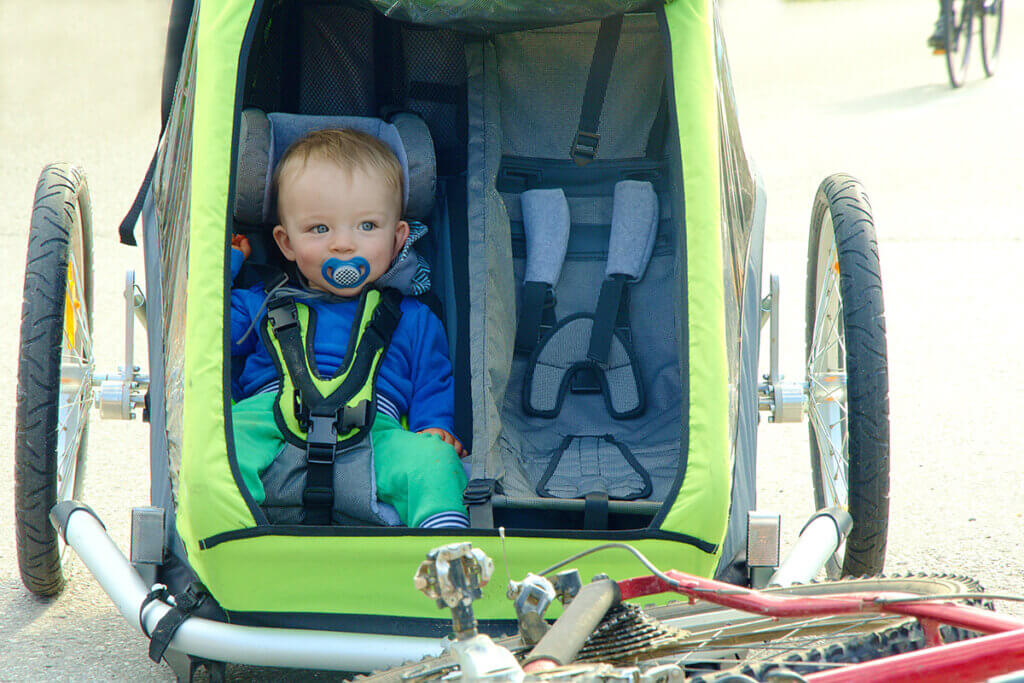
Brake system
The brake is a particularly important part of the bicycle trailer because it ensures safety. Some models are equipped with a hand brake, which is particularly suitable for riding on uneven roads. If you use your trailer in mountainous areas, this brake is necessary. For safe parking, your bicycle trailer needs a proper parking brake. In its function it is similar to the handbrake of a car. Many trailers have both braking systems, guaranteeing maximum safety.
Coupling
The coupling of the trailer is the link to the bicycle and is therefore also very important. It should have a coupling point that is as low as possible and a multiple plug connection. This means that the bicycle trailer will sway less and you can continue to use the bicycle’s luggage rack.
Frame versus axle coupling
A frame hitch has a very low centre of gravity and is attached to the frame of the bicycle. An axle hitch also has a low centre of gravity and, unlike the frame hitch, does not put any strain on the frame of the bicycle. It is attached to the rear wheel of the bicycle.
Frame couplings are often recommended because they allow more mobility while riding than axle couplings. They therefore allow better evasive manoeuvres while riding and make the trailer very tilt-resistant. Axle couplings, on the other hand, are compatible with almost all bicycles and allow the trailer to be coupled quickly.
When choosing a type of coupling, you must first check which one is compatible with your bicycle. Most couplings are now two-piece coupling systems, as they are safer than one-piece versions. The coupling is usually included in the delivery. However, if it does not fit your bike, you will need to buy a new one.
Multifunctionality
Children’s bicycle trailers can often take on other forms and functions. With 2-in-1 trailers, you can fold up or attach a third wheel with a simple handle and simply remove the drawbar. In this way, you can transform the child bike trailer into a pram in no time at all. However, 2-in-1 child bike trailers are also more expensive than simple versions, so you should think carefully beforehand about whether such a model makes sense for your purposes. If you want to stow the trailer in the car, you can choose a foldable or collapsible version. This way, cycling tours in distant regions are no problem.
Canopy
In order to protect your child as much as possible during the ride, the hood must be completely closable. The material should be weatherproof and protect against UV light. In summer, a fly net is practical and can usually be attached very easily with a zip or press studs. Since the hanger is at the height of the car exhausts, it should be ventilated so that pollutants do not collect. Roll-up sides are practical for this.
Accessories
Apart from reflectors and a safety flag, there are other extras you might need to use the child bike trailer. A bicycle helmet for your child is not compulsory, but it offers additional protection and is particularly useful in busy areas. Wheel covers prevent your child from grabbing the spokes and thus also increase protection. However, since the car should remain closed during the ride anyway, these are not a necessary addition.
If your child is still a baby, you will need a baby seat, a hammock or a seat reducer for the trailer. For babies under nine months, a hammock is the best choice because, unlike the alternatives, it is very soft and bounces particularly well. Baby seats are made of strong material and are usually very narrow, which is why they are also well suited for trailers with two seats. For particularly young babies, an additional neck support is also necessary, as they are not yet able to hold their head up straight independently.
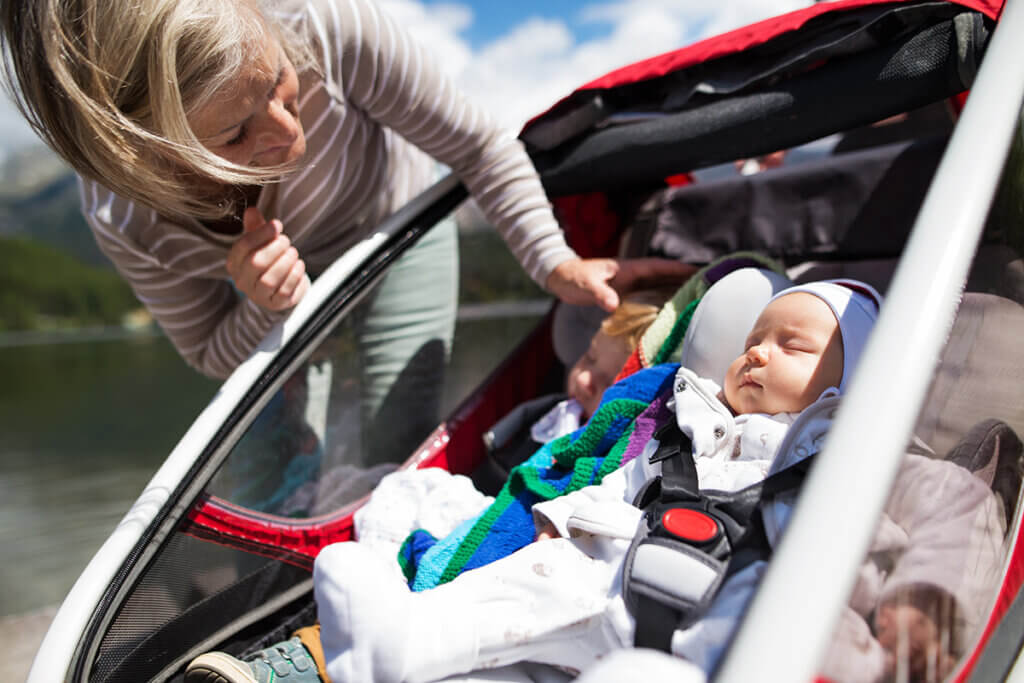
It is also worth buying a doormat for the children’s bicycle trailer. The interior quickly gets dirty from the child’s feet or toys. A rubber doormat catches the dirt, which can then also be easily transported outside. The mat itself can be cleaned with water. Alternatively, you can use an old car floor mat, but you may have to cut it to size first.
How much do children’s bicycle trailers cost?
There are many different bicycle trailers available at very different prices. Particularly inexpensive models are available from around 70 euros, while you have to reckon with four-digit sums for luxury models. How much you should spend on your trailer depends on its use. If you use it only occasionally, a model for a reasonable price is enough; if you use it frequently, it is worth spending a little more money. Especially if you want a 2-in-1 model or a foldable version, cheap trailers are out of the question. Also bear in mind that a high-quality model offers better quality, is more comfortable for your child and lasts longer.
Handling the children’s bicycle trailer
Once you have purchased a children’s bicycle trailer, you need to attach it properly to the bicycle. Since it also makes for a different riding experience, there are a few useful tips you should keep in mind.
The correct mounting
Before you attach the trailer to your bike, you should make sure that it is compatible with your bike. If this is the case, you can mount the hitch. Depending on the model, there are different ways of attaching the hitch. Most of the time, you need to attach it to the rear wheel of the bicycle. Then screw the connector to the axle of the trailer to make the connection between the trailer and the bicycle. Now you have to insert the bicycle connector into the hitch and secure it, this is usually done with a quick release fastener. Since all couplings differ from each other, it is essential that you follow the manufacturer’s instructions and the instructions for use.
Useful tips for driving with the trailer
Once the hitch is fitted and the trailer is connected to the bike, the riding fun can begin. Before each ride, check that all parts are screwed tight and that the drawbar is free to move. If this is not the case, you should tighten the screws so that the ride does not become a safety risk. Make sure that the tyre pressure is correct, it should be about 2.5 bar. If it is lower, you should inflate the tyres again.
Since driving with a trailer gives a different driving experience, you should definitely practise it before your first outing. It is best to rehearse the ride without a passenger at first in an area with little traffic. Concentrate especially on cornering and braking, because the braking distance is significantly longer with a bicycle trailer. When riding with the empty trailer is no longer a problem, you can load it with newspapers or other weights and ride more practice laps. Only when you feel completely safe riding should you put your child in the trailer.
If you are only transporting one child in the trailer, it is advisable to place him or her in the middle of the trailer so that it does not become unbalanced. If this is not possible, the child should at least sit on the side facing away from the road, as it is safer to get out away from traffic. When getting the child in and out of the trailer, always activate the parking brake so that neither the trailer nor the wheel tip over or roll away in the process.
Quick cleaning
Cleaning a bicycle trailer is usually very uncomplicated and quick. Since most trailers are made of solid materials, you can simply hose them down with a garden hose. For very stubborn dirt, you can also use a high-pressure cleaner. However, be sure to wait until the trailer is completely dry before the next trip.
How do I protect the children’s bicycle trailer from theft?
If the bicycle and trailer are parked in a locked room, they are covered by household insurance. With many insurance policies, you have the option of taking out additional insurance to protect the bicycle and trailer outside a room. However, the prerequisite is that both are secured with a lock. Spiral or U-locks that you attach to the frame of the bicycle and the trailer are well suited. Since the bicycle trailer is considered an accessory, it is only insured as long as it is lost together with the bicycle.
The legal regulations
Children’s bicycle trailers are legally bound by the European standard DIN EN 15918, which has been in force since 2013. All trailers must meet the safety requirements to be allowed to be used in road traffic. This is to protect the driver, the child and other road users.
The driver must be at least 16 years old to be allowed to ride a child bicycle trailer. He or she may only ride it on cycle paths and never faster than 30 kilometres per hour. The maximum weight of the trailer is 60 kilograms, including the weight of the child being carried.
The regulations for an e-bike
Special regulations apply to e-bikes as far as the transport of children in the trailer is concerned. Here, too, the rider must be 16 years old. In addition, the bike must have a maximum speed of 25 kilometres per hour.
If the trailer is wider than 60 centimetres, two white reflectors must be fitted at the front. However, they must not be further than 20 centimetres from the respective edge. If the trailer is wider than one metre, it must have at least one reflector on the left side. On the rear of the vehicle there must be two red rear lights, which must also not be further than 20 centimetres from the edge. Triangular reflectors, however, are not permitted.
Fig. 1: © photosis / stock.adobe.com | Fig. 12: © ARochau / stock.adobe.com | Fig. 3: © Jobakashii / stock.adobe.com | Fig. 4: © Sasenki / stock.adobe.com | Fig. 5: © Halfpoint / stock.adobe.com

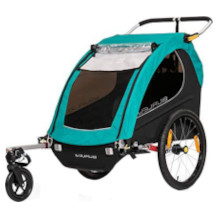
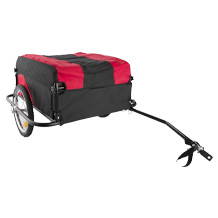








 331 reviews
331 reviews

